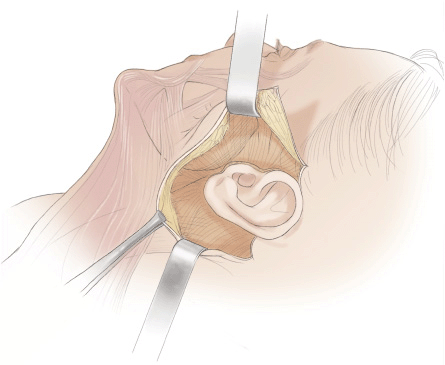Chapter 19. Short-Scar Facelift with Round-Block SMAS Treatment
Ithamar Nogueira Stocchero, MD
INDICATIONS
This technique is a superficial musculoaponeurotic system (SMAS) suspension method, and although a small undermining is usually done, it may be useful in any rhytidectomy involving subcutaneous undermining. Considering that this technique is essentially a purse-string suture, a great reduction in the surgical wound diameter will occur, thus allowing an easier execution and safer short-scar facelift, even in smokers and patients with significant alopecia.
PREOPERATIVE PREPARATION
In a survey of patients who were candidates for facelifts, most individuals expected procedures with minimal surgical stigmata, less-visible scars, a quick and comfortable recovery, low risk from surgery, early return to work, and fewer restrictions (considering themselves unable to give up habits). They also noted that they would accept good results rather than excellent ones, if possible, at lower costs. Expectations about long-lasting results were not present, especially if a painless postoperative course could be offered. The plastic surgeon must elucidate expectations before suggesting a technique to the patient. The facelift must reflect the patient’s own expression.
ANESTHESIA
General anesthesia or monitored conscious sedation is suitable for the procedure. Patients’ degree of anxiety will determine the best option.
POSITION AND MARKINGS
With the patient sitting on the operating table, the surgeon slides the facial skin toward the ear using his index finger, thus simulating the desired result. At the nearest point of the sideburn hair implantation, where the finger still maintains the intended result, an ink dot is drawn. This maneuver is repeated 4 or 5 times until a dotted line is drawn around the ear. This determines the minimum undermining needed to achieve the result.
The patient’s hair, head, and face are washed in a basin. The hair remains wet with antiseptic solution, and the head is prepped into the sterile field, allowing the surgeon to move it right and left, and to extend the neck.
If the procedure is done under general anesthesia, a 1:250,000 epinephrine-saline solution is injected into the marked area, around the ear, and in the submental and neck areas. If the procedure is done under local anesthesia, a 0.5% lidocaine solution is used together with the vasoconstrictive agent.
DETAILS OF PROCEDURE
It is usually recommended to perform liposuction of the submental region and neck prior to the facelift, using a 3-mm incision made behind the chin. After liposuction is completed, an inverted-omega beveled incision is made, starting approximately 3 mm above the border of the sideburn, so as to protect hair follicles, and then contoured around the ear and finishing transversally behind it, above a projected line that passes above the tragus.
The previously marked area is undermined at the subcutaneous plane by sharp dissection. Pinch tests pulling the SMAS are executed to confirm that the tissues will allow for good traction by bringing the skin together (if that is not possible, additional undermining may be required). After that, accurate hemostasis is done. The risorius-masseterian zone is exposed, as well as the cranial portion and the mandibular insertion of the platysma muscle, leaving the muscle prepared to be plicated (Fig. 19-1). Regardless of the technique used, there will be an overlapping of muscles in this area; it is, indeed, convenient to restore volume.

Figure 19-1 Minimal undermining to perform the running plication in the face.
Stay updated, free articles. Join our Telegram channel

Full access? Get Clinical Tree








